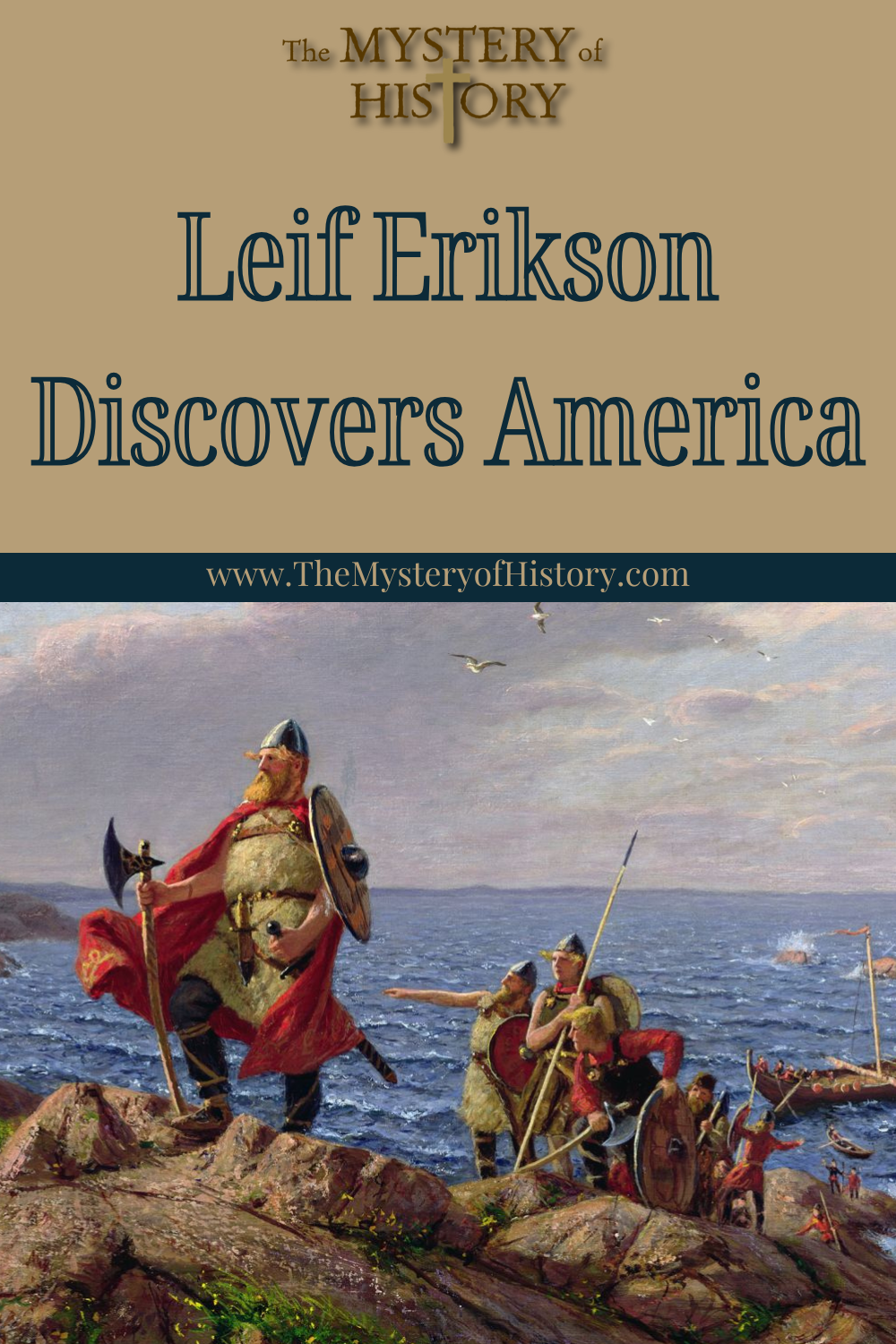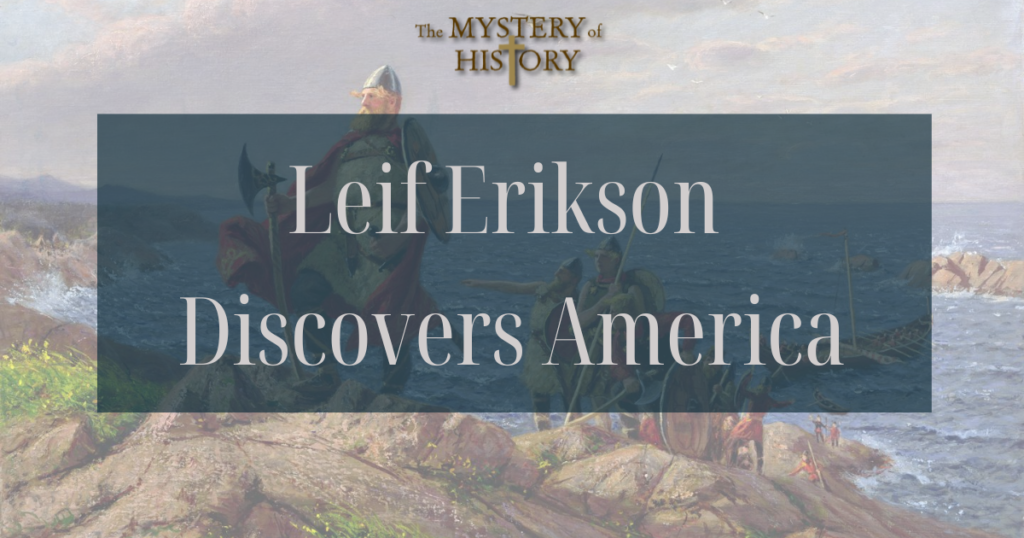Traditionally, Americans remember Christopher Columbus as the first white man to discover the New World. An old poem tells us, “In fourteen hundred ninety two, Columbus sailed the ocean blue.”1 However, according to Viking tradition, Leif Erikson was the first white man to “sail the ocean blue” and land on the mainland shores of North America. And it happened about 500 years before Columbus! Today we’ll look at both the facts and the folklore surrounding this significant event.

Enter our main character, Leif Erikson of Greenland. Young Leif wanted to meet the king of Norway, Olaf Tryggvason (oh lof TRIGG vay-son). Leif was intrigued by the amazing stories he had heard about the king from traders who sailed back and forth between Greenland, Iceland, and Norway. King Olaf was known for being tall, fierce, and strong, while also being generous. Besides all of this, King Olaf had converted to Christianity, which was intriguing to Leif Erikson. In 999, Leif sailed to Norway to meet King Olaf face to face. In the process of mingling with King Olaf, Leif also converted to Christianity.
Leif Erikson Embraces Christianity
We have no record of how genuine Leif ’s conversion was. Some say he may have embraced the king’s faith to keep trade relations strong between Greenland and Norway. Regardless, Leif was commissioned by King Olaf to take the Christian faith back to Greenland. Leif obliged, returning to Greenland with priests and the message of the Gospel. As the story goes, one of Leif’s first converts was his own mother, Tjodhild (thuh JODE hilde). She and many other Greenlanders embraced the teachings and forgiveness of Christ with grateful hearts. His father, Erik the Red, however, was obstinate toward the new religion. Though Tjodhild built a Christian chapel right on their own property, Erik kept his distance. He remained faithful to his Viking gods the rest of his life.
Meanwhile, some other interesting news was circulating. It seems that a Viking trader named Bjarni Herjolfsson (bee ARE nee HARE dee yolf son) was telling everyone about a wooded coastland he had seen to the west while blown off course from his travels. Bjarni sighted this land but never made it ashore. As a true Viking, Leif immediately wanted to explore it, but his father Erik was not so sure. As an old man and the leader of Greenland, he thought his days of exploring should be over. But Leif persisted in persuading his father to go with him. With reluctance, Erik the Red agreed to accompany the expedition. However, on the morning of their departure, Erik accidentally fell from his horse. He considered this fall to be a bad omen and backed out of the expedition. With everything set to go, it only made sense for Leif to proceed without him.
Leif Erikson Makes his Mark in History!
Around the year 1003, Leif Erikson made his mark in history with the yearlong voyage he undertook at the age of 21. It seems that Leif bought Bjarni’s ship and recruited 35 men to sail with him. Where to? They were not exactly sure. They didn’t know that the large continent of North America existed! They just headed northwest and then to the south.
According to one Viking saga, the first land Leif found was disappointing because it had no trees at all. He may have been on the outskirts of Baffin Island, located in what is now Nunavut, the Inuit territory in modern-day Canada.* Finding it rocky and desolate, Leif named it Helluland, meaning “Slab-land.” Next, it may be that Leif and his crew sailed along the coast of modern-day Labrador, a peninsula in northeastern Canada. He observed some forests there, but the land was rugged and uninviting. Leif named it Markland, or “Forestland,” and likely kept sailing to Newfoundland (NOO fund-land), Canada. And so, Leif Erikson was the first white man known to have visited the mainland continent of North America! Though he didn’t stay long, he and his crew stayed long enough to make history—and do a little exploring.
Leif Erikson and his men found endless natural resources of strong trees, thick grass, fresh salmon, and grapes. Some say that Leif named the location Vinland, or “Wineland,” because of the grapes. Others say it was named Vinland because the word vin in Old Norse means “green grass” or “meadow.” Regardless of why he named it Vinland, Leif Erikson called it home for a time. He and his men built sturdy stone and turf shelters at a small settlement called Leifsbudir, or “Leif ’s booths,” and stayed for the winter. One of the many things the men appreciated about their new home was the absence of frost on the ground. (They were so used to it in Greenland!) They also enjoyed the nearly equal periods of daylight and nighttime every 24 hours. This also was different from Greenland, where the sun shines for months and then goes away for months at a time. But even in this paradise Leif longed for his homeland. In less than a year, he returned to Greenland. Though he may have visited Vinland a few more times, he never made it his home.

Torvald and Freydid
Following the expedition of Leif Erikson, more and more Vikings made their way to North America with enough supplies and manpower to start a small settlement. Leif ’s brother Torvald went in 1011 with 60 men, 5 women, livestock, and supplies, planning for a permanent settlement. The Viking settlers fared well for a time. With the local natives, they traded things like dairy products and red cloth for furs and wood. They might have stayed much longer, but they began to run into some trouble. The native people were becoming more and more hostile toward them. The Vikings called these dark, stocky people Skraelings (SCRAY lings or SCREE yoo lings). They may have been Inuit, or they may have been Native Americans. (Of course, thousands of Native Americans were in North America long before Leif Erikson.) Whoever they were, they must not have been attractive to the Vikings. The name skraelings means “ugly people.” With numerous incidents between the Vikings and the skraelings, Torvald’s settlers soon felt it best to leave. They only returned on occasion for timber.
Some Viking sagas report that Leif Erikson’s sister Freydid (freh DID) made a later attempt to settle the land. To be more accurate, she tried to make money in the New World. Supposedly, Freydid took two ships back to Vinland, promising the crews of both ships profit from their fur trade with the native people. But Freydid went back on her word. She and her men murdered the crew of the other ship so they wouldn’t have to split the profits! If this incident wasn’t enough to make Freydid sound terrifying, folklore says that Freydid once scared off hostile skraelings from her camp by wildly beating her chest with a sword and yelling loudly. I’m not sure if she was brave or just a bit crazed! Either way, her reputation was not good at all, as told in the Viking sagas.
Though the sagas are full of interesting stories, it’s hard to know just how accurate they are since they were written down about two hundred years after the events took place. However, it seems to be true that Leif Erikson was once in North America. As recently as 1960, archaeologists found evidence of a Viking settlement on the northern tip of Newfoundland to back up the sagas. The archaeological site is called L’Anse aux Meadows (LONCE oh MEE dows), which means “the bay with the meadows.”
I think that American history books would tell a different story if the Vikings had succeeded in staying! You see, Christopher Columbus claimed that he sailed to Iceland in 1477 to research legends of the Viking discovery of the New World!2 If the claims of Columbus are accurate, then the Vikings may have had something to do with the famous voyage of Christopher Columbus in 1492. How about that?
Activities
All students: New World Bartering!
Make different “territories” around your house or room. Set up camp and give each student a limited amount of resources (snacks, water, sticks, blankets, etc.) making sure you give each student a different amount and differing types of items. Now, let the fun begin! Trade and barter for the supplies you need. Set criteria they have to meet (3 sacks of food, 2 bundles of firewood, 5 bottles of water needed per person to survive, for example.)
*In 1999, the Nunavut Territory and government, which had been approved in 1993, officially came into existence, giving the Inuit people their own self-governed territory within Canada. The name Nunavut means “Our Land.” Nunavut was created out of land that was previously part of the Northwest Territories, and it includes Baffin Island, the fifth largest island in the world.
References
1. “In 1492,” Teaching Heart, www.teachingheart.net/columbus.htm.
2. Alwyn A. Ruddock, “Columbus and Iceland: New Light on an Old Problem,” The Geographical Journal 136, no. 2 ( June 1970):177–189, https://jstor.org/stable/pdf/1796276.pdf?seq=1.



